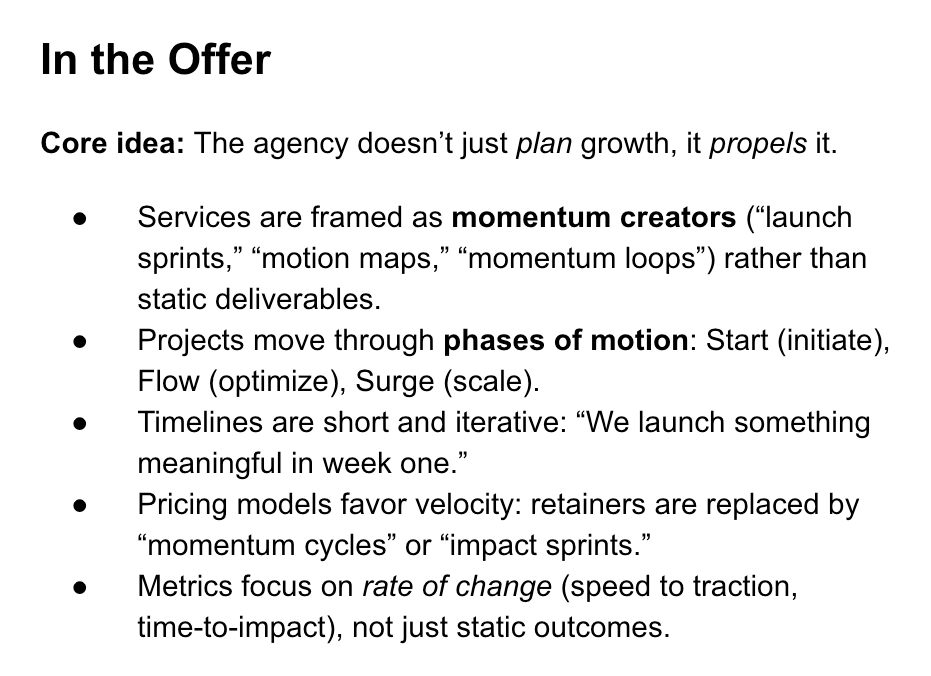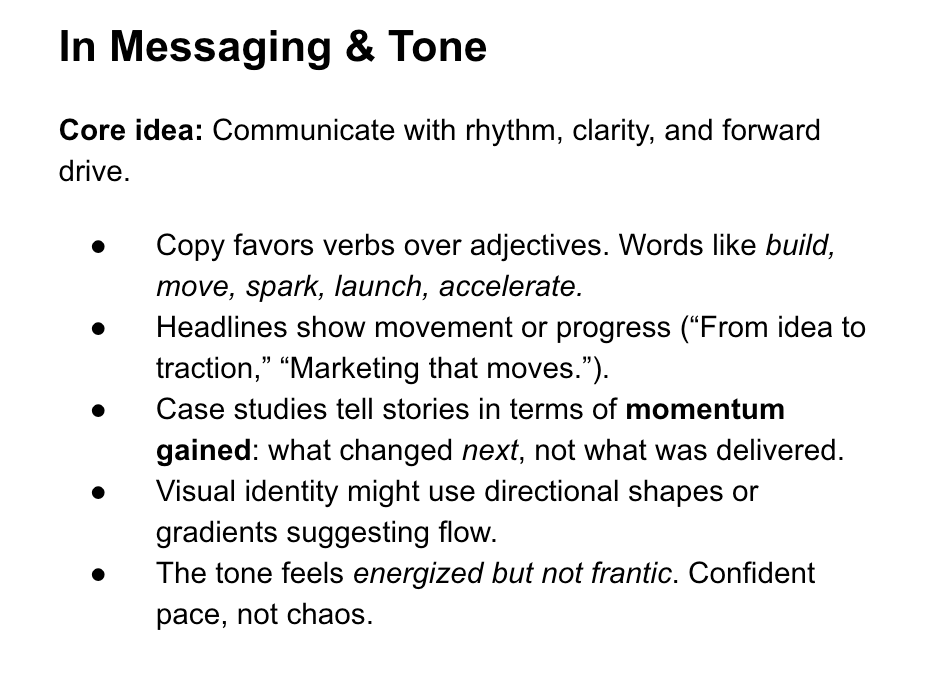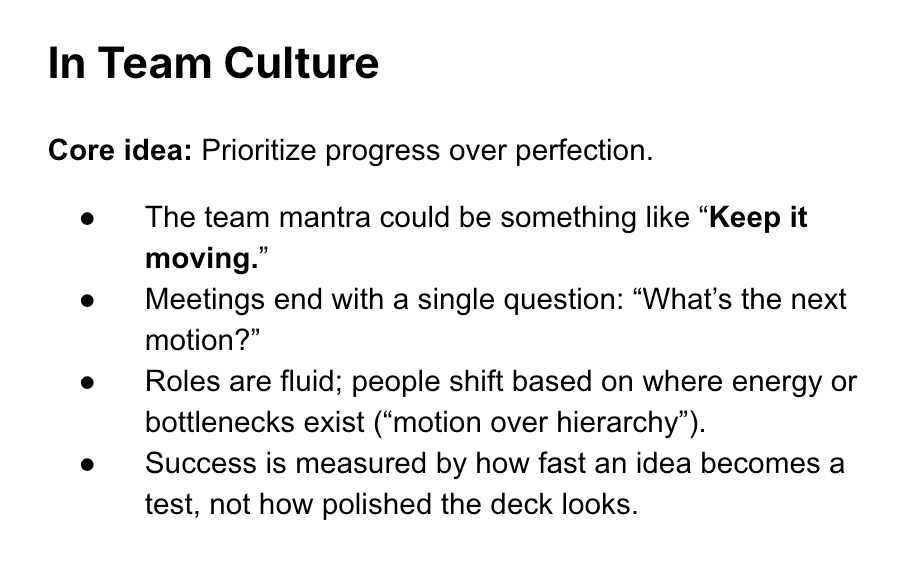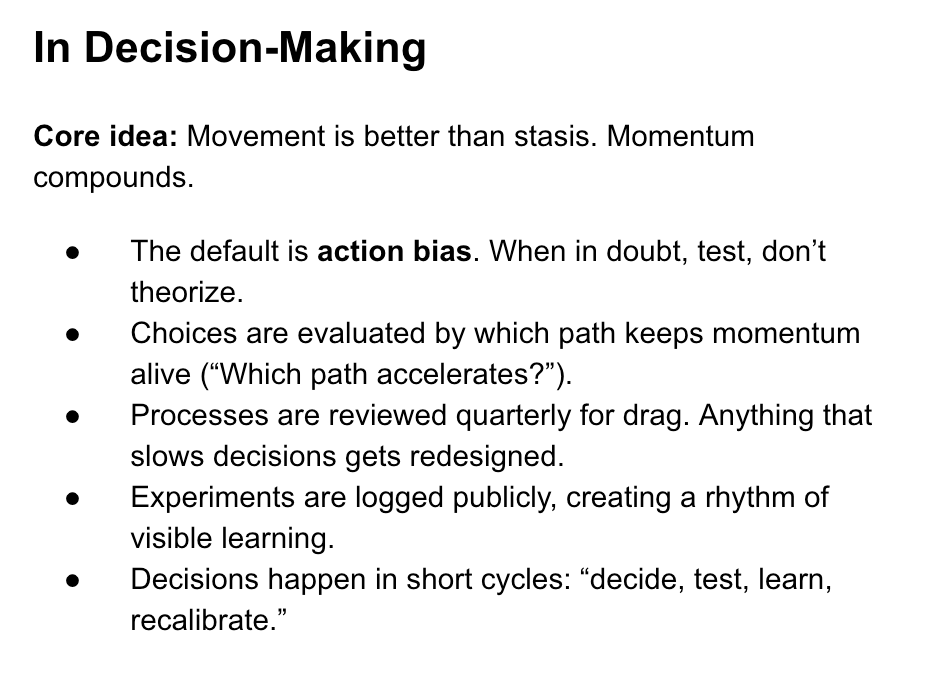How Your Positioning Should Show Up in Every Corner of Your Business
I gave a presentation on positioning at the All-In Agency Summit.
If you weren’t there, shame on you.
Only joking. Kind of.
But in my presentation, one section seemed to hit harder than all the others. It wasn’t about finding your positioning (though that’s important). It was about what you do with it once you have it.
Most agency owners treat positioning like it’s a messaging exercise.
They nail down their unique angle, update their website copy, maybe refresh their LinkedIn profile, and call it a day. The strategic equivalent of cleaning your desk and declaring your life in order.
They nail down their unique angle, update their website copy, maybe refresh their LinkedIn profile, and call it a day. But positioning that only lives in your marketing deck isn’t really positioning at all.
It’s just words. Nice words, probably in Futura Bold, but still, just words.
Real positioning bleeds into everything.
It shapes how you structure your offers, run your team meetings, make decisions, and even how clients experience working with you. When positioning is truly embedded in your business, it becomes a genuine differentiator, not just a claim you make.
Let me show you what I mean with a concrete example.
For the rest of this article, let’s assume our positioning noun is “Kinetic.”
We don’t just plan growth, we propel it. Everything about our business reinforces this idea of movement, momentum, and forward drive. Here’s how that actually shows up across the operation.
How positioning lives in your offer structure
This is where most people stop, but it’s actually just the beginning. Your positioning should fundamentally change how you package and deliver your services.
In our kinetic example, that means we’d frame everything as momentum creators. We wouldn’t offer “strategy deliverables” because that sounds static, like something you download and never open again.
Instead, we’d talk about launch sprints, motion maps, and momentum loops. The language reflects the outcome: things that create movement, not documents that sit in a folder.
Our project structure would follow phases of motion too. We’d start with initiate, move into flow where we optimize, and then surge where we scale.
Even the way we’d talk about timelines reinforces this. When scoping work, we’d lean into short, iterative cycles. “We launch something meaningful in week one” hits differently than “We’ll deliver the strategy in four weeks.”
Pricing models can reflect your positioning too. In this kinetic scenario, we’d move away from traditional retainers and toward what we’d call momentum cycles or impact sprints. The pricing structure itself communicates that we’re focused on velocity and results, not just hours logged.
And here’s something most agencies miss: your metrics should align with your positioning. Since we’re all about momentum in this example, we’d track rate of change. How fast did we get from idea to traction? How quickly did we reduce time-to-impact? We’d care about pipeline velocity rather than the number of deals.
These aren’t vanity metrics, they’re proof points that the positioning is real.
The messaging and tone side
This is the more obvious application, but there’s depth here that people often overlook.
Your copy should be doing heavy lifting to reinforce your positioning. In our kinetic example, that means favoring verbs over adjectives. Words like build, move, spark, launch, and accelerate would show up everywhere. They’re not just more dynamic to read, they reinforce that kinetic feeling we’d want people to associate with working with us.
Headlines are another place to embed your positioning. Instead of “Our approach to agency growth,” we’d say “From idea to traction” or “Marketing that moves.” Every headline is an opportunity to show, not tell.
Case studies are where positioning really comes alive in messaging. The way you frame results matters. In this kinetic scenario, we’d tell stories in terms of momentum gained, focusing on what changed next, not just what was delivered. The narrative arc itself reflects movement: where they were stuck, how we got things moving, what accelerated from there.
Even your visual identity can support your positioning. Think about the shapes, colors, and design elements you use. Do they reinforce your core idea?
In our example, we’d use directional elements, gradients that suggest flow, and design that feels like it’s in motion. Your brand doesn’t have to look the same as ours, but it should look like your positioning.
Tone is the subtle one. In our kinetic example, the tone would feel energized but not frantic. There’s forward momentum in how we’d write, but it’s confident pace, not chaos. If your positioning is about precision or craft, your tone should reflect that. If it’s about boldness, let that show. Your positioning should have a voice.
Where positioning shows up in team culture
This is where positioning stops being a marketing thing and starts being a business thing.
If your positioning is going to be believable to clients, it first has to be real for your team. In our kinetic example, that means we’d prioritize progress over perfection. I don’t say that to sound inspirational, I mean it operationally. We’d build systems that reward forward motion even when things aren’t polished yet.
Our team mantra could be something like “Keep it moving.” Not in a frantic way, but as a reminder that done and improving beats perfect and delayed. You might choose a different mantra based on your positioning, but having one helps everyone understand what matters most.
Meetings are a great place to reinforce culture. In this scenario, we’d end ours with a single question: “What’s the next motion?” It keeps the focus on momentum instead of getting stuck in analysis. If your positioning is about thoroughness or craft, maybe your question is “What did we miss?” or “How do we make this better?” The point is to make your positioning actionable in how people work.
Role fluidity is another cultural element that can support positioning. In our example, we’d shift people based on where energy or bottlenecks exist. It’s motion over hierarchy. If your positioning is about specialization or deep expertise, you might do the opposite, keeping roles very defined. Either way, your org structure should reflect your core idea.
Success metrics at the team level should match too. With kinetic positioning, we’d measure how fast an idea becomes a test, not how polished the deck looks. Your team should know what “winning” means in the context of your positioning.
How decision-making reflects your positioning
This one surprised me when I first made the connection, but it’s huge. The way you make decisions as a business either reinforces or contradicts your positioning.
In our kinetic example, movement beats stasis, so our default would be action bias. When we’re uncertain about something, we’d test instead of theorizing. We’d ask ourselves which path keeps momentum alive. That doesn’t mean we’d be reckless, it means we’ve decided that learning through doing aligns with who we are.
Your decision framework might look totally different. If your positioning is about precision or deep analysis, maybe your default is thorough research before action. The key is that your decision-making process should feel consistent with your positioning.
In this kinetic scenario, we’d evaluate choices by asking “Which path accelerates us?” If your positioning is about sustainability or longevity, you might ask “Which path is most sustainable?” or “Which choice are we still happy with in three years?” Let your positioning guide the lens you use for decisions.
Process reviews matter too. With kinetic positioning, we’d look at our processes quarterly and specifically ask what’s creating drag. Anything that slows momentum without adding real value gets redesigned. If your positioning is about craft, you might review processes to see where you’re cutting corners. Same practice, different lens.
One thing I’ve found helpful is logging experiments publicly within the team. It creates visible learning and reinforces that we’re always moving forward, always testing, always improving. Transparency about what we’re trying keeps everyone oriented around momentum.
With this kinetic approach, we’d also operate in short decision cycles. Decide, test, learn, recalibrate. The cycle itself is quick because that’s who we are. Your cycles might be longer if your positioning demands it, but being intentional about cycle time keeps your positioning real.
The client experience dimension
Here’s where positioning either becomes your reputation or gets exposed as marketing fluff. Clients don’t experience your positioning through your website. They experience it through the email chain where you’re two days late and still somehow composed.
The feeling should be consistent with your positioning from day one. In our kinetic example, that means clients should feel pulled forward, not dragged through a process. The experience itself should have momentum. If your positioning is about being thorough or detail-oriented, clients should feel taken care of and never rushed.
Onboarding is your first impression at the work level. With kinetic positioning, we’d start with quick wins that create immediate movement. Not fake wins, real ones that matter. This builds trust that momentum is real, not just promised. Your onboarding might focus on deep discovery and taking time to get it right. Either approach can be great, as long as it matches your positioning.
Progress visibility is critical. In this scenario, we’d give clients live updates, not monthly reports. They’d see things moving in real time. This isn’t about more communication for the sake of it, it’s about making momentum tangible. If your positioning is about being strategic or high-level, maybe you communicate less frequently but with more depth. The format should match the promise.
Collaboration rhythm matters too. With our kinetic approach, we’d do biweekly energy checkpoints instead of bloated monthly reviews. The cadence reinforces that we’re moving quickly and staying in sync.
Language clients use about you is the ultimate test. When clients describe the partnership, do their words reflect your positioning? In our kinetic example, we’d want to hear things like “easy to get going” and “impossible to lose momentum.” What do you want clients saying about you? That’s your north star for client experience design.
How your brand behaves in public
This is about how the world outside your client base experiences you. Your positioning should be visible even to people who aren’t working with you yet.
In our kinetic example, that means the brand would feel like it’s in perpetual motion. Social content is a good example. We’d lean into videos, live demos, and evolving narratives instead of static graphics and quote cards. Not because those formats are better objectively, but because they reinforce kinetic energy.
Your website can show positioning too. In this kinetic scenario, we’d use motion graphics, active language, and case studies that evolve. If your positioning is about being established and reliable, maybe your site feels more solid and permanent, with weight and authority in the design. Both can be effective.
The way you announce things matters. With kinetic positioning, we wouldn’t do big reveals. We’d do continuous launches and improvements. “Here’s what’s new this week” instead of “We’re excited to finally announce...” The communication style itself reflects momentum. Your style might be fewer, bigger announcements if that fits your positioning better.
Think about brand voice as the external expression of your positioning. In our kinetic example, it would be momentum: always forward, never idle. Yours might be precision: clear, exact, thorough. Or boldness: confident, provocative, unapologetic. Whatever it is, it should show up consistently in every public touchpoint.
Why this actually matters
Look, you can have decent positioning that only lives in your marketing and still run a successful agency. But you’ll always be fighting an uphill battle to differentiate. When a prospect talks to three agencies with similar messaging, they pick based on gut feel, price, or whoever they talked to last.
When positioning runs through your entire operation, something different happens. Prospects feel the consistency. They hear it in your language, see it in your process, and experience it in how you show up. It stops being a claim and becomes proof.
This also makes your business more defensible. Copy can be stolen. Messaging can be mimicked. But the way you actually operate? That’s much harder to replicate. When positioning is deeply embedded, it becomes your real competitive advantage.
For agency owners looking to do this in their own businesses, here’s where I’d start: pick one area beyond messaging. Maybe it’s how you structure your offers, or how you run team meetings, or how clients experience progress updates. Make that one thing deeply consistent with your positioning. Then expand from there.
Your positioning isn’t just about standing out in the market. It’s about building a business that actually works the way you say it does. That’s when differentiation stops being a marketing exercise and starts being your reality.
And honestly, reality’s a pretty good differentiator.








